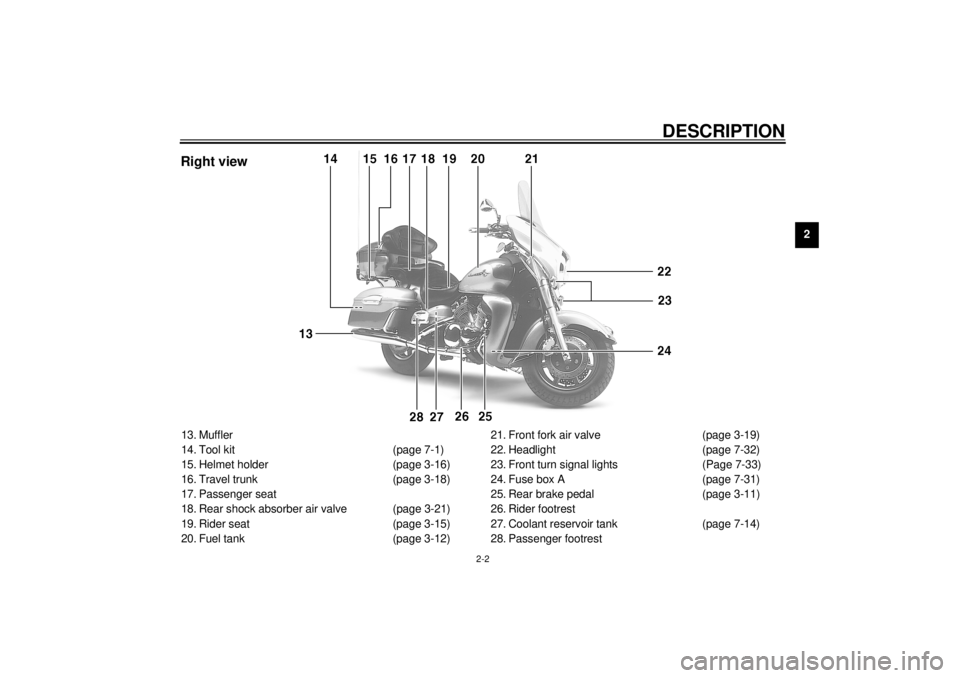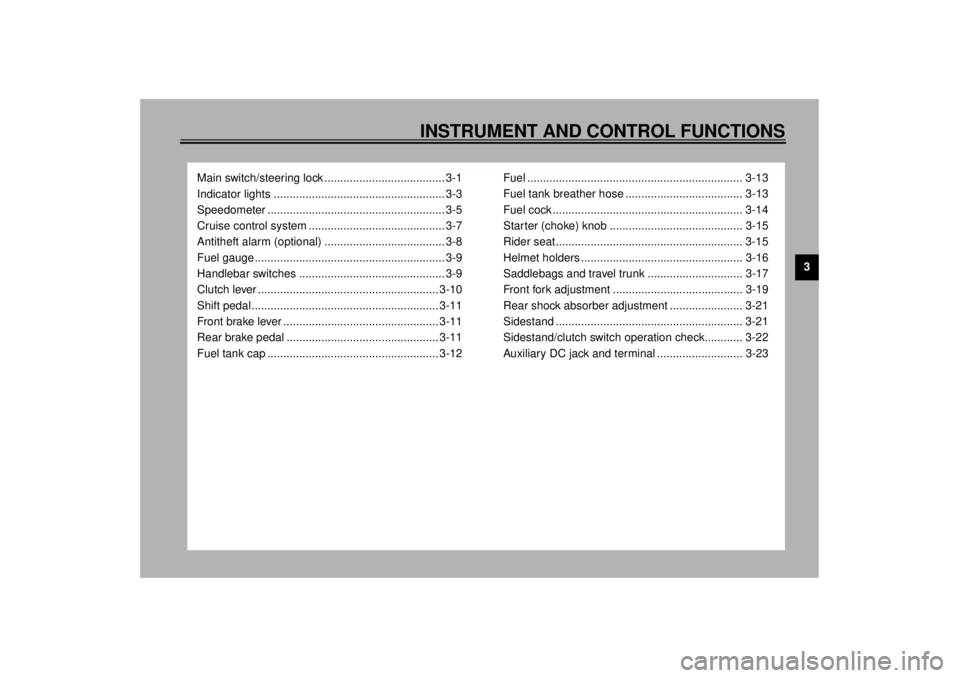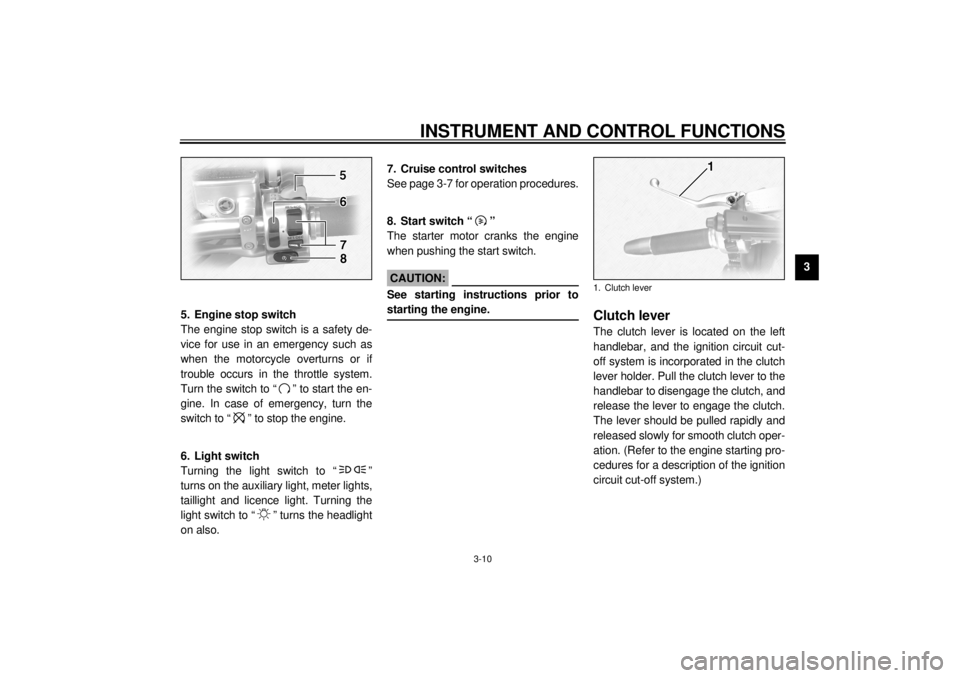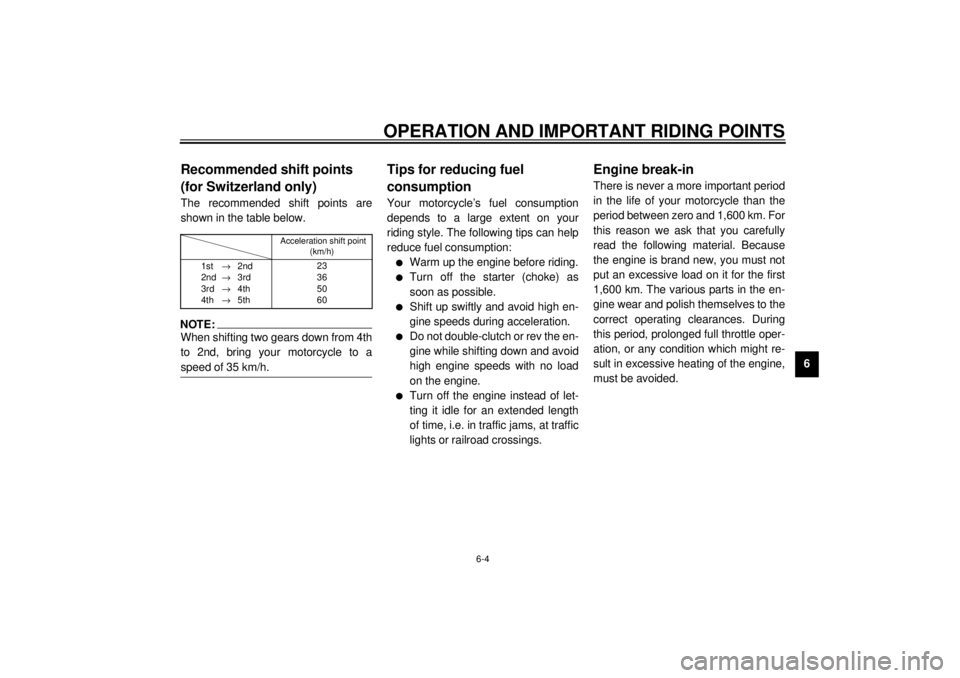lights YAMAHA XVZ1300TF 2000 Owners Manual
[x] Cancel search | Manufacturer: YAMAHA, Model Year: 2000, Model line: XVZ1300TF, Model: YAMAHA XVZ1300TF 2000Pages: 121, PDF Size: 19.23 MB
Page 11 of 121

2-1
2
EAU00026
2-DESCRIPTIONLeft view1. Shift pedal (page 3-11)
2. Starter (choke) knob (page 3-15)
3. Fuel tank cap (page 3-12)
4. Fuel cock (page 3-14)
5. Battery (page 7-29)
6. Coolant reservoir tank (page 7-14)7. Fuse box B (page 7-31)
8. Saddlebag (page 3-17)
9. Helmet holder (page 3-16)
10. Licence light (page 7-34)
11. Tail/brake light (page 7-33)
12. Rear turn signal lights (page 7-33)
E_5jc_Description.fm Page 1 Saturday, October 16, 1999 1:07 PM
Page 12 of 121

DESCRIPTION
2-2
2
13. Muffler
14. Tool kit (page 7-1)
15. Helmet holder (page 3-16)
16. Travel trunk (page 3-18)
17. Passenger seat
18. Rear shock absorber air valve (page 3-21)
19. Rider seat (page 3-15)
20. Fuel tank (page 3-12)21. Front fork air valve (page 3-19)
22. Headlight (page 7-32)
23. Front turn signal lights (Page 7-33)
24. Fuse box A (page 7-31)
25. Rear brake pedal (page 3-11)
26. Rider footrest
27. Coolant reservoir tank (page 7-14)
28. Passenger footrestRight view
E_5jc_Description.fm Page 2 Saturday, October 16, 1999 1:07 PM
Page 14 of 121

3
INSTRUMENT AND CONTROL FUNCTIONS
Main switch/steering lock ...................................... 3-1
Indicator lights ...................................................... 3-3
Speedometer ........................................................ 3-5
Cruise control system ........................................... 3-7
Antitheft alarm (optional) ...................................... 3-8
Fuel gauge ............................................................ 3-9
Handlebar switches .............................................. 3-9
Clutch lever ......................................................... 3-10
Shift pedal ........................................................... 3-11
Front brake lever ................................................. 3-11
Rear brake pedal ................................................ 3-11
Fuel tank cap ...................................................... 3-12Fuel .................................................................... 3-13
Fuel tank breather hose ..................................... 3-13
Fuel cock ............................................................ 3-14
Starter (choke) knob .......................................... 3-15
Rider seat........................................................... 3-15
Helmet holders ................................................... 3-16
Saddlebags and travel trunk .............................. 3-17
Front fork adjustment ......................................... 3-19
Rear shock absorber adjustment ....................... 3-21
Sidestand ........................................................... 3-21
Sidestand/clutch switch operation check............ 3-22
Auxiliary DC jack and terminal ........................... 3-23
E_5jc_FunctionsTOC.fm Page 1 Saturday, October 16, 1999 1:07 PM
Page 17 of 121

INSTRUMENT AND CONTROL FUNCTIONS
3-3
3
EAU00056
Indicator lights
EAU00058
1. Turn indicator lights “ ” / “ ”
The corresponding indicator flashes
when the turn switch is moved to the
left or right.
EAU00063
2. High beam indicator light “ ”
This indicator comes on when the
headlight high beam is used.
EAU01209
3. Oil level indicator light “ ”
This indicator light will come on if the oil
level is low. To check that the indicator
light is working properly:
l
Turn the engine stop switch to
“ ” and the main switch to “ON”.
l
Put the transmission in neutral or
apply the clutch lever.
l
Push the start switch.
If the indicator light does not come on
while pushing the start switch, have a
Yamaha dealer inspect the electrical
circuit.
NOTE:@ Even if the oil is filled to the specified
level, the indicator light may flicker
when riding on a slope or during sud-
den acceleration or deceleration, but
this is normal. @
E_5jc_Functions.fm Page 3 Saturday, October 16, 1999 1:08 PM
Page 18 of 121

INSTRUMENT AND CONTROL FUNCTIONS
3-4
3
EAU01774
4. Overdrive indicator light “O/D”
This indicator light will come on when
the transmission is in overdrive (5th
gear).
EAU00091
5. Engine trouble indicator light
“”
This indicator light will come on or flash
if trouble occurs in a monitoring circuit.
In such a case, take the motorcycle to a
Yamaha dealer to have the self-diag-
nostic systems checked.
EAU00079
6. Fuel level indicator light “ ”
When the fuel level drops below ap-
proximately 3.5 L, this light will come
on. When this light comes on, switch
the fuel cock to “RES”. Then, fill the
tank at the first opportunity.
EAU01773
7. Cruise control indicator lights
See page 3-7 for an explanation of the
functions of these indicator lights.
EAU00061
8. Neutral indicator light “ ”
This indicator comes on when the
transmission is in neutral.
EAU01257*
9. Coolant temperature indicator
light “ ”
This indicator light will come on if the
engine overheats. If the light comes on,
stop the engine immediately and allow
the engine to cool. To check that the in-
dicator light is working properly:l
Turn the engine stop switch to
“ ” and the main switch to “ON”.
l
Put the transmission in neutral or
apply the clutch lever.
l
Push the start switch.
If the indicator light does not come on
while pushing the start switch, have a
Yamaha dealer inspect the electrical
circuit.
E_5jc_Functions.fm Page 4 Saturday, October 16, 1999 1:08 PM
Page 22 of 121

INSTRUMENT AND CONTROL FUNCTIONS
3-8
3 creased by more than 8 km/h, cruise
control will be deactivated until the trav-
eling speed returns to within 8 km/h of
the set speed.
Deactivating cruise control
Applying the front or rear brake or dis-
engaging the clutch will automatically
deactivate cruise control.
Push the “CANCEL” switch to manually
deactivate cruise control and return to
normal throttle operation.
NOTE:@ l
When cruise control is deactivat-
ed, the “RES” (resume) indicator
light will come on.
l
The traveling speed starts de-
creasing as soon as cruise control
is deactivated, unless the throttle
grip is turned.
@
Push the “RES/ACC” side of the cruise
control button to reactivate cruise con-
trol. The traveling speed will return to
the previously set speed. The “RES” in-
dicator light will flash during this time
and then go off. Finally, the “SET” indi-
cator light will come on.
Push the “CRUISE” switch to the right
to turn the cruise control system off
completely.
EWA00019
WARNING
@ If some trouble occurs in the cruise
control system, the “SET” and
“RES” indicator lights will flash si-
multaneously. If this occurs, turn off
the cruise control system and have
a Yamaha dealer check it. @
EAU00109
Antitheft alarm (optional)An antitheft alarm can be equipped to
this motorcycle. Consult your Yamaha
dealer to obtain and install the alarm.
E_5jc_Functions.fm Page 8 Saturday, October 16, 1999 1:08 PM
Page 24 of 121

INSTRUMENT AND CONTROL FUNCTIONS
3-10
3
EAU00138
5. Engine stop switch
The engine stop switch is a safety de-
vice for use in an emergency such as
when the motorcycle overturns or if
trouble occurs in the throttle system.
Turn the switch to “ ” to start the en-
gine. In case of emergency, turn the
switch to “ ” to stop the engine.
EAU01871
6. Light switch
Turning the light switch to “ ”
turns on the auxiliary light, meter lights,
taillight and licence light. Turning the
light switch to “ ” turns the headlight
on also.
EAU01859
7. Cruise control switches
See page 3-7 for operation procedures.
EAU00143
8. Start switch “ ”
The starter motor cranks the engine
when pushing the start switch.
EC000005
CAUTION:@ See starting instructions prior to
starting the engine. @
EAU00152
Clutch leverThe clutch lever is located on the left
handlebar, and the ignition circuit cut-
off system is incorporated in the clutch
lever holder. Pull the clutch lever to the
handlebar to disengage the clutch, and
release the lever to engage the clutch.
The lever should be pulled rapidly and
released slowly for smooth clutch oper-
ation. (Refer to the engine starting pro-
cedures for a description of the ignition
circuit cut-off system.)1. Clutch lever
E_5jc_Functions.fm Page 10 Saturday, October 16, 1999 1:08 PM
Page 58 of 121

PRE-OPERATION CHECKS
5-2
5
NOTE:Pre-operation checks should be made each time the motorcycle is used. Such an inspection can be thoroughly accom-
plished in a very short time; and the added safety it assures is more than worth the time involved.
WARNING
If any item in the PRE-OPERATION CHECK is not working properly, have it inspected and repaired before operating
the motorcycle.Chassis fasteners• Make sure that all nuts, bolts and screws are properly tightened.
• Tighten if necessary.—
Fuel• Check fuel level.
• Fill with fuel if necessary.3-12 ~ 3-13
Lights, signals and
switches• Check for proper operation. 7-32 ~ 7-34 ITEM CHECKS PAGE
E_5jc_Preop.fm Page 2 Saturday, October 16, 1999 1:10 PM
Page 64 of 121

OPERATION AND IMPORTANT RIDING POINTS
6-4
6
EAU02941
Recommended shift points
(for Switzerland only)The recommended shift points are
shown in the table below.CF-25ENOTE:@ When shifting two gears down from 4th
to 2nd, bring your motorcycle to a
speed of 35 km/h. @
EAU00424
Tips for reducing fuel
consumptionYour motorcycle’s fuel consumption
depends to a large extent on your
riding style. The following tips can help
reduce fuel consumption:l
Warm up the engine before riding.
l
Turn off the starter (choke) as
soon as possible.
l
Shift up swiftly and avoid high en-
gine speeds during acceleration.
l
Do not double-clutch or rev the en-
gine while shifting down and avoid
high engine speeds with no load
on the engine.
l
Turn off the engine instead of let-
ting it idle for an extended length
of time, i.e. in traffic jams, at traffic
lights or railroad crossings.
EAU01128
Engine break-inThere is never a more important period
in the life of your motorcycle than the
period between zero and 1,600 km. For
this reason we ask that you carefully
read the following material. Because
the engine is brand new, you must not
put an excessive load on it for the first
1,600 km. The various parts in the en-
gine wear and polish themselves to the
correct operating clearances. During
this period, prolonged full throttle oper-
ation, or any condition which might re-
sult in excessive heating of the engine,
must be avoided.
Acceleration shift point
(km/h)
1st®2nd
2nd®3rd
3rd®4th
4th®5th23
36
50
60
E_5jc_Operation.fm Page 4 Saturday, October 16, 1999 1:10 PM
Page 106 of 121

MOTORCYCLE CARE AND STORAGE
8-2
8
ECA00036
CAUTION:@ l
Avoid using strong acidic wheel
cleaners, especially on spoked
wheels. If you do use such
products for hard-to-remove
dirt, do not leave it on any long-
er than instructed, then thor-
oughly rinse it off with water,
immediately dry the area and
apply a corrosion protection
spray.
l
Improper cleaning can damage
windshields, cowlings, panels
and other plastic parts. Use
only a soft, clean cloth or
sponge with mild detergent and
water to clean plastic.
l
Do not use any harsh chemical
products on plastic parts. Be
sure to avoid using cloths or
sponges which have been in
contact with strong or abrasive
cleaning products, solvent or
thinner, fuel (gasoline), rust re-
movers or inhibitors, brake flu-
id, antifreeze or electrolyte.
l
Do not use high-pressure wash-
ers or steam-jet cleaners since
they cause water seepage and
deterioration in the following ar-
eas: seals (of wheel bearings,
swingarm bearings, forks and
brakes), electric components
(couplers, connectors, instru-
ments, switches, lights, audio
system and speakers), saddle-
bags, travel trunk, breather hos-
es and vents.
l
For motorcycles equipped with
a windshield: Do not use strong
cleaners or hard sponges as
they will cause dulling or
scratching. Some cleaning
compounds for plastic may
leave scratches on the wind-
shield. Test the product on a
small hidden part of the wind-
shield to make sure they do not
leave any marks. If the wind-
shield is scratched, use a quali-
ty plastic polishing compound
after washing.
@
E_5jc_Cleaning.fm Page 2 Saturday, October 16, 1999 1:12 PM